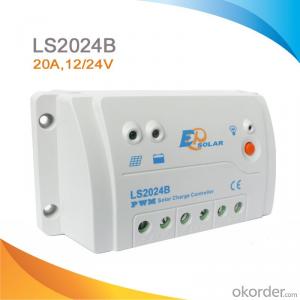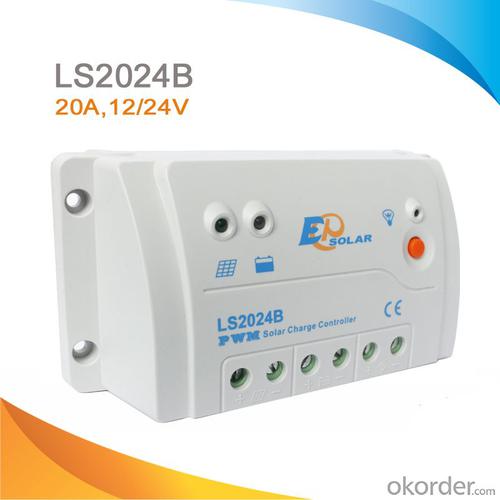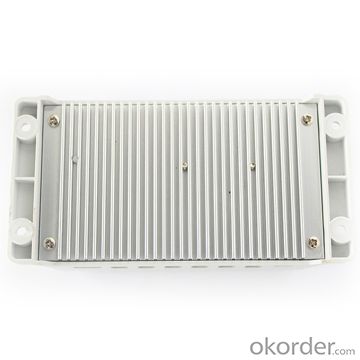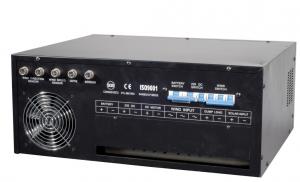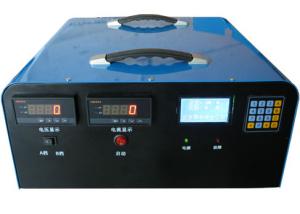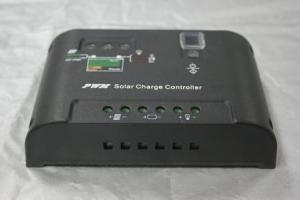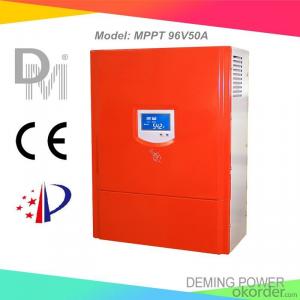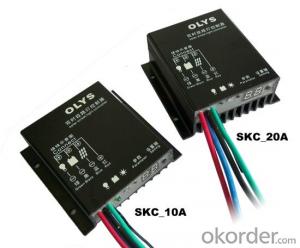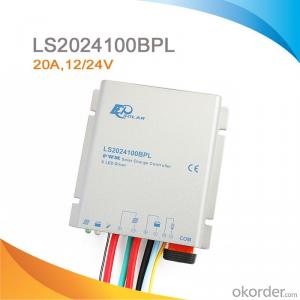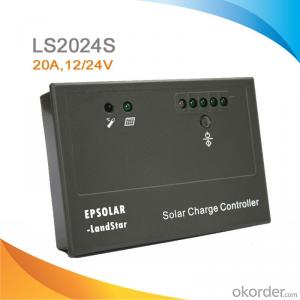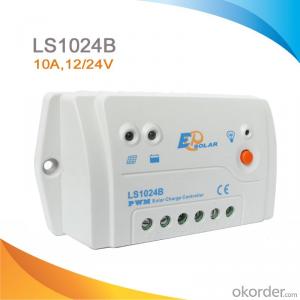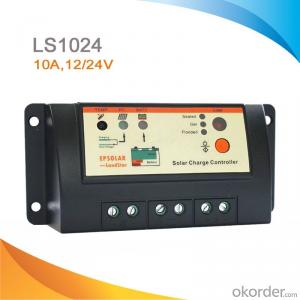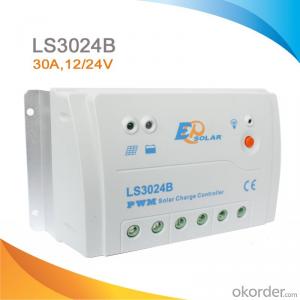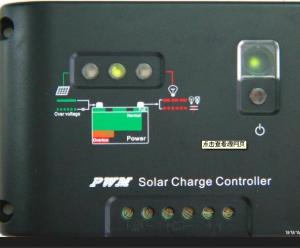PWM Solar Charge Controller,20A 12/24V,LS2024B
OKorder Service Pledge
OKorder Financial Service
You Might Also Like
Descriptions:
A charge controller, or charge regulator is basically a voltage and/or current regulator to keep batteries from overcharging. It regulates the voltage and current coming from the solar panels going to the battery. Most "12 volt" panels put out about 16 to 20 volts, so if there is no regulation the batteries will be damaged from overcharging. Most batteries need around 14 to 14.5 volts to get fully charged.
Features:
·High efficiency PWM charging with temperature compensation
·3 LEDs shows PV charging, battery and load status
·External temperature sensor interface
·RS-485 bus communication
·Open standard Modbus communication protocol
·Software update function
·Diversified load control modes : Manual, Light ON/OFF, Light ON+ Timer, Time Control
·Battery type selection: Gel, sealed, flooded and User type
·Real-time monitor
·Programmable parameters
·LVD or SOC load disconnect function
·Energy statistics function
Electronic Protections:
·PV short circuit
·PV reverse polarity
·Battery overcharge
·Battery over discharge
·Battery reverse polarity
·Load short circuit
·Load overload
·Overheating
Specification:
Electrical parameters | LS1024B | LS2024B | LS3024B |
Nominal System Voltage | 12 / 24V auto work | ||
Rated Battery Current | 10A | 20A | 30A |
Maximum battery voltage | 50V | ||
Grounding | Common positive | ||
Self-consumption | 8.4mA(12V),7.8mA(24V) | ||
Temp. compensation | -3mV/℃/2V(25℃ ref) | ||
Equalize charging voltage | Sealed: 14.6V, Flooded: 14.8V, User-defined: 9~17V | ||
Boost charging voltage | Gel: 14.2V, Sealed: 14.4V, Flooded: 14.6V, User-defined: 9~17V | ||
Float charging voltage | Gel /Sealed /Flooded: 13.8V, User-defined: 9~17V | ||
Low voltage reconnect voltage | Gel /Sealed /Flooded: 12.6V, User-defined: 9~17V | ||
Low voltage disconnect voltage | Gel /Sealed /Flooded: 11.1V, User-defined: 9~17V | ||
Working temp. | -35℃~+55℃ | ||
Humidity | ≤95% (NC) | ||
Enclosure | IP30 | ||
Dimension | 138.6x69.3x37mm | 159.6x81.4x47.8mm | 200.6x101.3x57mm |
Terminal | 4mm2 | 10mm2 | 10mm2 |
Net weight | 0.13kg | 0.3kg | 0.5kg |


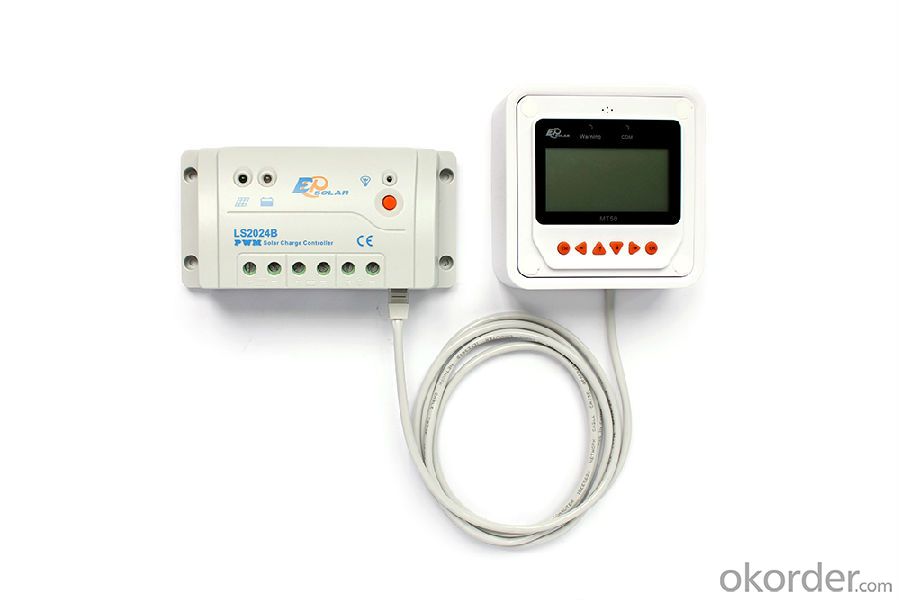
- Q: Can a solar controller be used with a solar-powered wind turbine?
- No, a solar controller cannot be used with a solar-powered wind turbine. Solar controllers are designed specifically for regulating and optimizing solar energy systems, while wind turbines require a separate controller designed for managing wind power generation.
- Q: Can a solar controller be used in off-grid solar systems?
- Yes, a solar controller can be used in off-grid solar systems. In fact, it is an essential component of any off-grid solar system. A solar controller, also known as a charge controller, regulates the amount of charge going into the battery bank from the solar panels. It prevents overcharging of the batteries during periods of high solar input and protects the batteries from being completely drained during periods of low solar input. This helps to prolong the lifespan of the batteries and ensures their optimal performance. Additionally, solar controllers often have additional features such as load control and monitoring capabilities, making them an integral part of off-grid solar systems.
- Q: How do I determine the maximum load output voltage for a solar controller?
- To determine the maximum load output voltage for a solar controller, you need to consider a few factors. 1. Consult the controller's specifications: Check the user manual or product specifications provided by the manufacturer. The maximum load output voltage is usually mentioned in these documents. Look for the "maximum load voltage" or a similar term. 2. Consider the solar panel voltage: The solar controller regulates the voltage from the solar panel to the load. Therefore, the maximum load output voltage should be lower than the maximum voltage that the solar panel can produce. Ensure that the controller's maximum load output voltage is compatible with the solar panel's specifications. 3. Consider the load voltage requirements: Determine the voltage requirements of the devices or appliances you plan to connect to the solar controller. Ensure that the maximum load output voltage of the controller is suitable for powering these devices. If the load voltage requirements are lower than the controller's maximum load output voltage, it should work fine. 4. Safety precautions: It is important to note that exceeding the maximum load output voltage can potentially damage the connected devices or appliances. Therefore, it is crucial to ensure that the load voltage requirements are within the specified range of the solar controller. By considering the controller's specifications, the solar panel voltage, load voltage requirements, and taking necessary safety precautions, you can determine the maximum load output voltage for a solar controller effectively.
- Q: How do I protect a solar controller from lightning strikes?
- To protect a solar controller from lightning strikes, it is recommended to use surge protectors or lightning arresters specifically designed for solar power systems. These devices help divert excessive voltage caused by lightning strikes away from the controller, preventing damage to the equipment. Additionally, grounding the solar system properly and ensuring all electrical connections are secure can further protect the controller from lightning-induced power surges.
- Q: Can a solar controller be used with solar-powered remote data logging systems?
- Yes, a solar controller can be used with solar-powered remote data logging systems. A solar controller helps regulate the charging and discharging of batteries in a solar power system, ensuring optimal performance and preventing overcharging or damage. This is essential for remote data logging systems that rely on solar power to operate efficiently and sustainably.
- Q: How do you connect solar panels to a solar controller?
- To connect solar panels to a solar controller, you will typically need to connect the positive (+) and negative (-) leads of the solar panels to the corresponding terminals on the solar controller. This is usually done by using appropriate wires or cables and ensuring a secure connection. It is important to follow the specific instructions provided by the manufacturer of your solar panels and solar controller to ensure proper and safe installation.
- Q: How does a solar controller handle voltage fluctuations from the solar panels?
- A solar controller or charge controller is a device used in solar power systems to regulate and control the flow of electricity between the solar panels and the battery bank. One of the key functions of a solar controller is to handle voltage fluctuations from the solar panels. When sunlight strikes the solar panels, it generates direct current (DC) electricity. However, the voltage output of solar panels can vary depending on factors such as the intensity of sunlight, temperature, and shading. These voltage fluctuations can be harmful to the battery bank as they can overcharge or undercharge the batteries, leading to reduced battery lifespan and performance. To handle voltage fluctuations, a solar controller employs a technique called Maximum Power Point Tracking (MPPT). MPPT is a technology that ensures the solar panels operate at their maximum power output, regardless of the fluctuations in voltage. The solar controller continuously monitors the voltage and current from the solar panels and tracks the optimal operating point, where the panels produce the most power. By constantly adjusting the electrical load on the panels, the MPPT algorithm ensures that the panels operate at their maximum power output, even when the voltage fluctuates. The solar controller achieves this by dynamically adjusting the resistance across the panels, thereby optimizing the voltage and current levels. This allows the solar panels to consistently deliver a stable and optimal voltage to the battery bank, regardless of any fluctuations in the environment. In addition to MPPT, solar controllers also incorporate various protective features to handle voltage fluctuations. These features include overcharge protection, which prevents the batteries from being overcharged when the solar panels produce excessive voltage, and over-discharge protection, which prevents the batteries from being excessively discharged when the solar panels produce insufficient voltage. Overall, a solar controller plays a crucial role in handling voltage fluctuations from the solar panels. By utilizing MPPT technology and incorporating protective features, it ensures that the solar power system operates efficiently, maximizing the power output from the panels while safeguarding the battery bank from damage caused by voltage fluctuations.
- Q: How do you test the functionality of a solar controller?
- To test the functionality of a solar controller, you can follow these steps: 1. Ensure that the solar controller is properly installed and connected to the solar panel and battery. 2. Check the display or indicator lights on the controller to ensure they are functioning correctly. 3. Verify that the solar controller is receiving power from the solar panel by checking the voltage readings on the controller's display or using a multimeter. 4. Test the charging functionality by monitoring the battery voltage and ensuring it is increasing when the solar panel is exposed to sunlight. 5. Check if the solar controller is properly regulating the charging process by observing if it prevents overcharging or over-discharging of the battery. 6. Test the load control feature by connecting a load, such as a light bulb or fan, to the controller's load terminals and ensuring it operates as expected. 7. If applicable, test any additional features of the solar controller, such as timers or temperature compensation, to ensure they are functioning correctly. 8. Finally, monitor the solar controller's performance over a period of time to ensure it consistently operates as intended.
- Q: Can a solar controller be used with solar panels that are connected to a solar cooling system?
- Yes, a solar controller can be used with solar panels that are connected to a solar cooling system. A solar controller is an essential component of any solar power system, including solar cooling systems. It regulates the flow of electricity from the solar panels to the cooling system, ensuring that the panels are operating at their optimal efficiency and that the cooling system is receiving the right amount of power. The solar controller helps manage the charging and discharging of the batteries in the system, preventing overcharging or excessive discharge, which can lead to damage. It also monitors the voltage and current output from the solar panels, ensuring that the cooling system receives a steady and consistent power supply. In a solar cooling system, the solar panels collect sunlight and convert it into electricity, which is then used to power the cooling system. The solar controller plays a vital role in controlling the power flow and ensuring that the cooling system operates effectively. By utilizing a solar controller, the solar cooling system can maximize its energy efficiency, reduce energy consumption, and increase overall system performance. It also helps to extend the lifespan of the solar panels and batteries by preventing any potential damage caused by irregular power flow. In conclusion, a solar controller is a crucial component in a solar cooling system that allows for the efficient and effective use of solar panels to power the cooling system.
- Q: How does a solar controller handle electrical noise from the solar panels?
- A solar controller handles electrical noise from the solar panels by utilizing various filtering techniques and electronic components such as capacitors and inductors. These components help suppress and eliminate electrical noise interference, ensuring a steady and clean flow of power to the connected devices or batteries. Additionally, advanced solar controllers may incorporate advanced algorithms and digital signal processing to further minimize the impact of electrical noise on the overall performance of the solar system.
Send your message to us
PWM Solar Charge Controller,20A 12/24V,LS2024B
OKorder Service Pledge
OKorder Financial Service
Similar products
Hot products
Hot Searches
Related keywords
